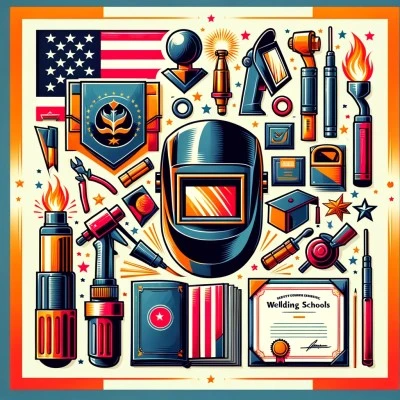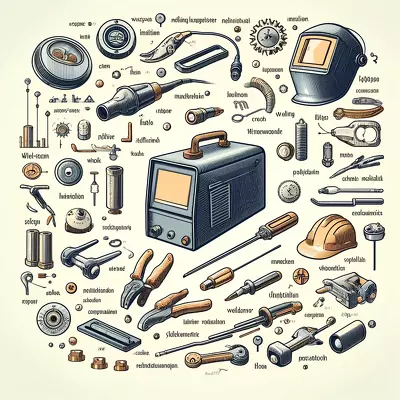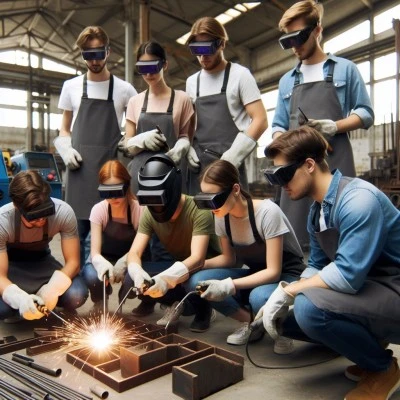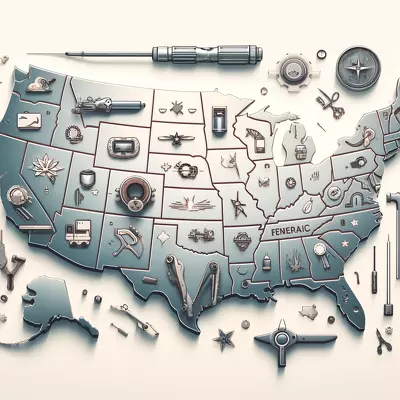From Novice to Professional: How to Get a Job as a Welder and Excel in the Industry

Discover the exciting world of welding and embark on a rewarding career path. This article offers valuable insights, tips, and resources to help you navigate the journey from aspiring welder to a skilled professional, ensuring you’re equipped with the knowledge needed to land your dream job in this in-demand trade.
I. Introduction: How to Get a Job as a Welder
A. The Crucial Role of Welding in Modern Industries
Welding, the process of joining metals through heat and pressure, plays a vital role in numerous industries, including construction, manufacturing, automotive, and aerospace. Its applications are essential to creating and maintaining infrastructure, vehicles, and equipment that drive our modern world. The demand for skilled welders is constantly growing, making it a stable and lucrative career choice for those interested in a hands-on profession.
B. Reaping the Rewards of a Welding Career
A career in welding offers numerous benefits, such as job security, competitive wages, and opportunities for growth and specialization. As a welder, you’ll gain exposure to various industries, allowing you to explore various professional paths and find the one that best suits your interests and talents. Moreover, welding is a trade with a low barrier to entry, making it an ideal choice for those who prefer learning through practical experience over traditional academic paths.
II. Essential Skills and Training for Welders
A. Mastering the Fundamentals of Welding Techniques
- Shielded Metal Arc Welding (SMAW)
Also known as stick welding, SMAW is a versatile and widely used welding technique. It involves using a consumable electrode coated in flux to create an electric arc, which melts the workpiece and the electrode, forming a strong joint. As a beginner, learning SMAW is crucial due to its prevalence in various industries. - Gas Metal Arc Welding (GMAW)
GMAW, or MIG welding, uses a continuous wire electrode and a shielding gas to protect the weld pool from atmospheric contaminants. This technique is popular for its relatively easy learning curve and adaptability, making it suitable for various materials and thicknesses. - Tungsten Inert Gas (TIG) Welding
TIG welding utilizes a non-consumable tungsten electrode and an inert shielding gas, producing high-quality, precise welds. It is particularly favored in industries requiring clean and accurate welds, such as aerospace and automotive. Mastery of TIG welding can boost your employability and open doors to specialized roles.
B. Becoming a Certified Welding Professional
- American Welding Society (AWS) Certifications
Obtaining certifications from the American Welding Society (AWS) can greatly enhance your credibility as a welder. AWS offers various certifications, including the Certified Welder and Certified Welding Inspector programs, which require passing a rigorous examination to prove your welding proficiency. - Other Industry-Specific Certifications
Depending on your desired career path, you may also want to pursue industry-specific certifications, such as those offered by the American Society of Mechanical Engineers (ASME) or the American Petroleum Institute (API). These certifications can make you more marketable and allow you to work in specialized fields.
C. Apprenticeships and On-the-Job Training
- Benefits of Apprenticeships
Apprenticeships offer invaluable hands-on experience, allowing you to learn directly from seasoned professionals while earning a wage. They often lead to full-time employment and provide essential networking opportunities. Moreover, apprenticeships help you gain practical skills and knowledge that are difficult to acquire in a classroom setting. - Finding Apprenticeship Opportunities
Contact local trade schools, community colleges, or welding unions to find apprenticeship opportunities, as they often have connections with companies offering apprenticeship programs. Additionally, you can search for job boards online or contact local businesses directly to inquire about potential openings.
III. Crafting a Compelling Welder Resume
A. Showcasing Your Skills and Experience
When crafting your welder resume, emphasize the relevant skills and experiences that showcase your expertise in the field. Highlight any hands-on experience gained through internships, apprenticeships, or past jobs, and mention specific welding techniques you are proficient in. Remember to include relevant soft skills, such as problem-solving, attention to detail, and teamwork.
B. Certifications and Training: A Testament to Your Expertise
Your resume should prominently feature your certifications and training, demonstrating your commitment to the profession and your competence in the field. List any certifications earned from recognized organizations like AWS, ASME, or API, along with any specialized training courses you’ve completed that are relevant to the job you’re applying for.
C. Prioritizing Safety and Proper Practices
Welding involves potential hazards, making safety a paramount concern for employers. Emphasize your knowledge of safety practices, including personal protective equipment (PPE), proper handling of materials, and adherence to safety guidelines. If you’ve completed any safety-related courses or training, mention them in your resume.
IV. Effective Job Search Strategies for Welders
A. Building a Strong Network in the Welding Community
Networking is crucial in finding job opportunities in the welding field. Connect with fellow welders, instructors, and industry professionals through social media, online forums, and local organizations. Building relationships within the community can lead to job referrals, career advice, and valuable insights into the industry.
B. Harnessing the Power of Job Search Websites and Resources
Use job search websites and resources specifically tailored to the welding profession, such as the AWS Career Center, industry-specific job boards, and trade-specific websites. Regularly check these resources for new job postings and set up job alerts to stay informed about the latest opportunities.
C. Attending Industry Events and Job Fairs
Industry events and job fairs provide excellent opportunities to meet potential employers, expand your network, and learn about the latest trends in the welding field. Attend local, regional, or national events to showcase your skills, submit your resume, and secure on-the-spot interviews. Watch for events organized by welding organizations, trade schools, or community colleges.
V. Preparing for a Successful Welder Job Interview
A. Digging Deeper: Researching Potential Employers
Before attending a job interview, research the potential employer better to understand their business, industry, and specific needs. Please familiarize yourself with their projects, clients, and company culture. This information will help you tailor your responses during the interview and demonstrate a genuine interest in working for the company.
B. Proving Your Mettle: Demonstrating Practical Welding Knowledge
Employers often assess a candidate’s practical welding knowledge during the interview process. Be prepared to discuss the welding techniques you have experience with, the types of materials you have worked on, and any specialized skills or certifications you possess. Demonstrating your practical knowledge will reassure employers of your competence and ability to contribute to their team.
C. Thinking on Your Feet: Showcasing Problem-Solving Abilities
Welders frequently encounter challenges and must adapt to various situations while maintaining safety and quality standards. During the interview, you may be asked about specific problems you have faced and how you resolved them. Prepare to discuss examples that showcase your problem-solving abilities and critical thinking skills. This will highlight your technical expertise and demonstrate your ability to approach challenges with a solutions-oriented mindset.
VI. FAQs
Q: What basic welding techniques should I learn to get a job as a welder?
A: Familiarize yourself with Shielded Metal Arc Welding (SMAW), Gas Metal Arc Welding (GMAW), and Tungsten Inert Gas (TIG) Welding, as these techniques are widely used across various industries.
Q: Are welding certifications necessary for employment?
A: While only sometimes required, certifications from recognized organizations like the American Welding Society (AWS) can greatly enhance your credibility and increase your chances of getting hired.
Q: How can I gain practical experience in welding?
A: Apprenticeships, internships, and on-the-job training are excellent ways to gain hands-on experience, learn from seasoned professionals, and build your skills in a real-world setting.
Q: What should I include in my welder resume?
A: Highlight your relevant skills and experience, showcase your certifications and training, and emphasize your safety practices and procedures knowledge.
Q: How can I find job opportunities in the welding field?
A: Leverage your professional network, utilize job search websites and resources specific to the welding profession, and attend industry events and job fairs to discover new opportunities.
Q: How can I prepare for a welder job interview?
A: Research the potential employer, be ready to demonstrate your practical welding knowledge, and prepare examples showcasing your problem-solving abilities and critical thinking skills.
Q: What are some growth opportunities and career paths for welders?
A: As a welder, you can explore various industries and specialize in specific techniques, work as a welding instructor, or advance to supervisory and management roles. Continuous learning and skill development can open new opportunities and career paths.
VII. Conclusion
A. The Path of Continuous Learning and Skill Development
In the ever-evolving world of welding, continuous learning and skill development are crucial to staying competitive and growing in your career. Attend workshops, webinars, and conferences to stay up-to-date with industry trends and pursue further certifications and training to expand your skill set. Embrace new technologies and methods to enhance your expertise and adaptability.
B. Charting Your Course: Growth and Advancement in Welding
A career in welding offers numerous opportunities for growth and advancement. By honing your skills, networking, and gaining experience, you can explore various industries and specialize in specific techniques or sectors. Consider roles in welding instruction, supervision, or management, which can further expand your career options. Ultimately, your commitment to the profession, passion for learning, and willingness to embrace new challenges will guide you toward securing your dream job as a welder.
VIII. Suggested Readings
Embarking on a career in welding requires practical experience and a solid foundation of knowledge. To help you become a successful welder, we’ve compiled a list of suggested readings and resources. These materials cover various aspects of welding, from techniques and certifications to career advice and industry insights. Delve into these resources to comprehensively understand the welding profession and equip yourself with the tools to secure your dream job.
- “Welding For Dummies” by Steven Robert Farnsworth
This beginner-friendly guide offers a comprehensive introduction to welding, covering various techniques, tools, and safety procedures. It’s an excellent starting point for aspiring welders looking to familiarize themselves with the basics. - “Welding Skills” by R.T. Miller and Jonathan F. Gosse
This textbook is widely used in welding courses and explains various welding processes, materials, and techniques in depth. It also includes practical exercises and projects to help develop your skills. - American Welding Society (AWS) Website (https://www.aws.org/)
The AWS website offers a wealth of resources for welders, including certification information, industry news, and educational materials. It’s an indispensable resource for staying up-to-date on the latest developments and trends in the welding field. - “Blueprint Reading for Welders” by A.E. Bennett and Louis J. Siy
This book is a comprehensive guide to understanding and interpreting welding blueprints, an essential skill for any professional welder. It covers various aspects of blueprint reading, including symbols, abbreviations, and welding specifications. - “The Procedure Handbook of Arc Welding” by The Lincoln Electric Company
This classic reference book provides an extensive overview of arc welding processes, equipment, and techniques. It’s an invaluable resource for novice and experienced welders looking to expand their knowledge and improve their skills.
By immersing yourself in these suggested readings and resources, you’ll gain a well-rounded understanding of the welding profession, improve your skills, and be better prepared to navigate the job market. With dedication and perseverance, you’ll be well on your way to securing your dream job as a welder.





